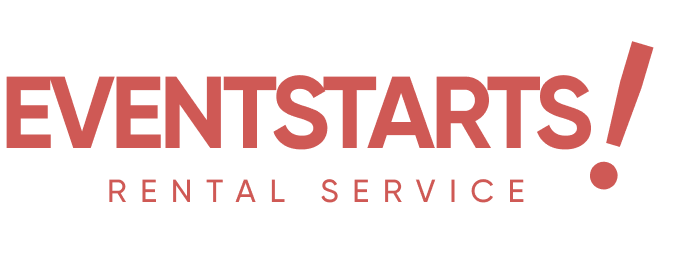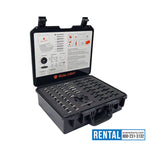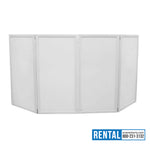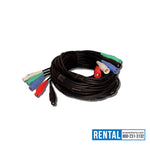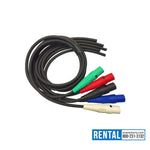You have no items in your shopping cart.
When planning any event — from weddings and conferences to live concerts and outdoor festivals — audio equipment is one of the most critical components. Without clear sound, even the most visually stunning event can fall flat. That’s why many organizers choose to rent professional sound systems, microphones, and mixers instead of investing in expensive gear.
But renting audio equipment isn't as simple as picking a few speakers and hitting “confirm.” Without proper planning, technical understanding, and communication with your rental provider, you might end up with a system that’s underpowered, incompatible, or worse — completely unusable for your venue.
To help you avoid costly mistakes and embarrassing technical failures, we’ve compiled a list of the top 10 mistakes to avoid when renting audio equipment for your next event.
1. Not Knowing Your Event Requirements
Before you start browsing catalogs or contacting vendors, take the time to clearly define your event’s needs. This includes:
-
Venue size – A small indoor room requires a completely different setup than a large outdoor field.
-
Audience size – Will you need to project sound to 30 people or 3,000?
-
Type of content – Are you amplifying speeches, music, or both?
-
Venue type – Indoors and outdoors require very different audio solutions due to acoustics and environmental noise.
If you don’t consider these factors, you might end up with audio equipment that is either too weak (resulting in poor sound coverage) or too powerful (causing echo, feedback, and hearing fatigue).
💡 Pro tip: Make a checklist of event details before requesting a quote from your rental company. The more they know, the better they can help you choose the right gear.
2. Choosing the Wrong Type of Speakers
Not all speakers are created equal. Choosing the wrong type can lead to poor sound quality or a system that doesn’t fit your venue.
Some key distinctions to understand:
-
Active (powered) speakers: Include built-in amplifiers. Great for simple setups, especially when you have limited tech support.
-
Passive (unpowered) speakers: Require separate amplifiers. Often used in more complex or professional configurations.
-
Line array systems: Ideal for large events like festivals or concerts. They offer consistent sound coverage across wide areas.
-
Standalone PA systems: Better suited for smaller events or speeches.
Many people also forget about subwoofers, which handle low-end frequencies (bass). These are essential for music-heavy events like DJ sets or live bands.
🎤 Don’t forget: speaker placement matters too. Poorly placed speakers can cause echo, dead zones, or feedback.
3. Underestimating Power Requirements
One of the most overlooked — and potentially dangerous — mistakes in sound system rental is underestimating the power needs of the equipment.
Professional audio systems require stable and sufficient electrical power. If your venue doesn’t have enough outlets, or if the circuits can’t handle the load, you could blow fuses, damage equipment, or experience power failures mid-event.
Things to consider:
-
Total wattage draw of the speakers, amplifiers, and mixing boards
-
Availability and type of electrical outlets (110V vs. 220V)
-
Distance to the nearest power source (long cable runs can cause voltage drops)
Always check with your venue manager or bring in a certified technician to evaluate the site. Also, ask your rental provider if they supply power distribution systems or if you’ll need to rent those separately.
⚡ Pro tip: Never plug high-wattage gear into the same circuit as lighting or catering equipment.
4. Forgetting About Microphones and Accessories
Renting speakers and a mixer is only half the equation. Many people forget that microphones — and their accessories — are just as essential.
There are several types of microphones commonly used in events:
-
Wired microphones – Reliable and lower-cost, but limited by cable length.
-
Wireless microphones – Provide mobility, ideal for speakers, performers, or panel discussions.
-
Lapel (lav) mics – Great for interviews or business presentations.
-
Headset mics – Popular with fitness instructors or stage performers who need hands-free movement.
Don’t forget the accessories:
-
Mic stands
-
Windscreens (especially for outdoor events)
-
Spare batteries for wireless systems
-
Receivers and antennas for multi-mic setups
🎙️ For events with multiple speakers or performers, always ensure you have enough microphones and a mixing board that supports multiple input channels.
5. Skipping the Sound Check
You’d be surprised how many event planners neglect to schedule a proper sound check — only to discover feedback, distortion, or dead zones once the event starts.
A sound check allows you to:
-
Balance volume levels across microphones and instruments
-
Identify and correct feedback loops
-
Test all audio equipment connections and signal chains
-
Adjust EQ settings for room acoustics
If you’re short on time, do a line check at minimum — testing each input one by one.
🎧 Always plan for at least 30–60 minutes of sound testing before the event starts — more if you're hosting a concert or large performance.
6. Not Considering Acoustic Challenges
Even with the best gear, poor acoustics can ruin your event. Many venues — especially large halls or gyms — suffer from echo, reverberation, or muddy sound.
Common acoustic problems:
-
Reflective surfaces (glass, tile, concrete)
-
Outdoor wind noise
-
Ambient sounds from crowds, traffic, or HVAC systems
Solutions include:
-
Using directional microphones to isolate voices
-
Employing audio processing equipment like equalizers or compressors
-
Adding acoustic treatments (drapes, foam panels) if possible
🌬️ For outdoor events, consider wind screens for mics and always check the wind direction during setup.
7. Assuming One Size Fits All
A major mistake is thinking the same sound system will work for every type of event. Each occasion has its own audio demands.
Examples:
-
A small corporate meeting may only need two speakers and a podium mic.
-
A wedding reception needs multiple wireless microphones, background music, and DJ equipment.
-
A rock concert requires powerful subwoofers, monitor wedges, and a full mixing console.
💼 Always work with your rental provider to tailor the audio equipment package to your specific event type and audience size.
8. Poor Communication with the Rental Company
Failing to provide clear information to your sound equipment rental company can lead to serious issues.
What to communicate:
-
Detailed schedule of your event
-
Load-in/load-out times and access info
-
Technical rider or stage plot (for concerts)
-
Whether you need on-site tech support
Also, carefully review the rental agreement. Does it include:
-
Delivery and setup?
-
On-site technician?
-
Insurance and liability terms?
-
Backup equipment in case of failure?
📝 A transparent and thorough conversation with your vendor prevents surprises — and builds trust for future rentals.
9. Ignoring Setup and Breakdown Logistics
Setting up professional audio equipment takes time and planning. Many organizers underestimate how long it takes to:
-
Transport gear to the venue
-
Run cables safely and cleanly
-
Conduct a sound check
-
Break down and pack up everything after the event
Logistics to consider:
-
Are there elevators or stairs?
-
Is there parking or a loading dock?
-
Are there union labor requirements at the venue?
⏱️ Build at least 2–4 hours into your schedule for setup and teardown, depending on complexity. Coordinate closely with your rental company on timing.
10. Not Testing Equipment Before the Event
Never assume everything will “just work.” Even new or well-maintained audio gear can fail — especially when transported or used in unfamiliar environments.
What to test:
-
Every microphone, cable, and speaker
-
All input channels on your mixer
-
Wireless signal range
-
Battery levels and spare parts
It’s also wise to ask for backup equipment (like an extra mic or DI box) for critical events — just in case.
🔌 An extra 10 minutes of testing can save your entire event.
Conclusion
Renting audio equipment is often the most practical and affordable way to deliver great sound at your event — but only if you do it right. By avoiding these 10 common mistakes, you’ll save time, money, and the stress of last-minute problems.
✅ Know your event needs
✅ Choose the right gear
✅ Communicate with your vendor
✅ Always test and prepare in advance
At EventStarts.com, we offer professional-grade sound system rental, expert advice, and reliable service you can trust. Whether you're hosting a concert, wedding, or corporate event, we’ll help you find the perfect audio setup — and avoid all the mistakes in this list.
